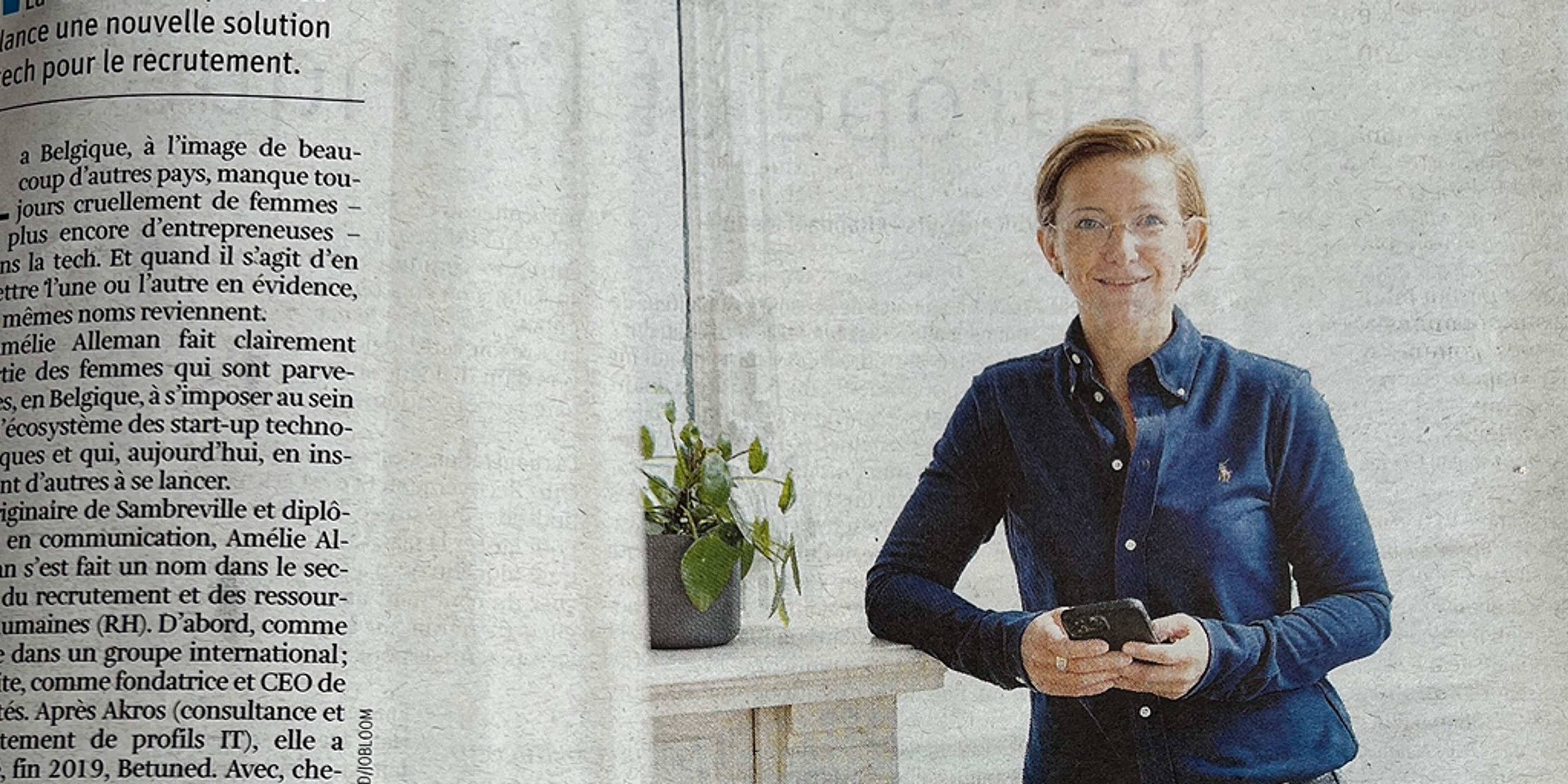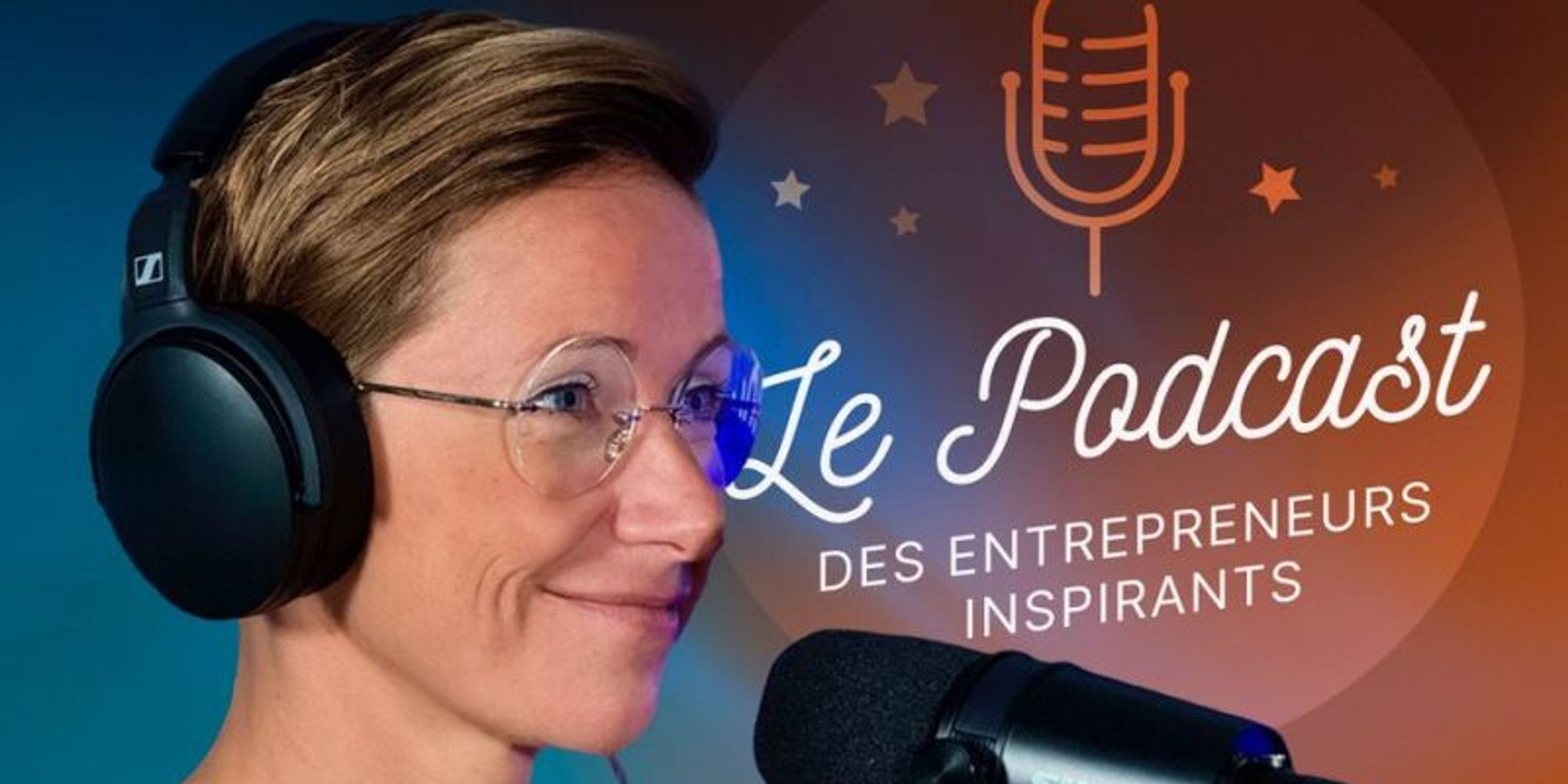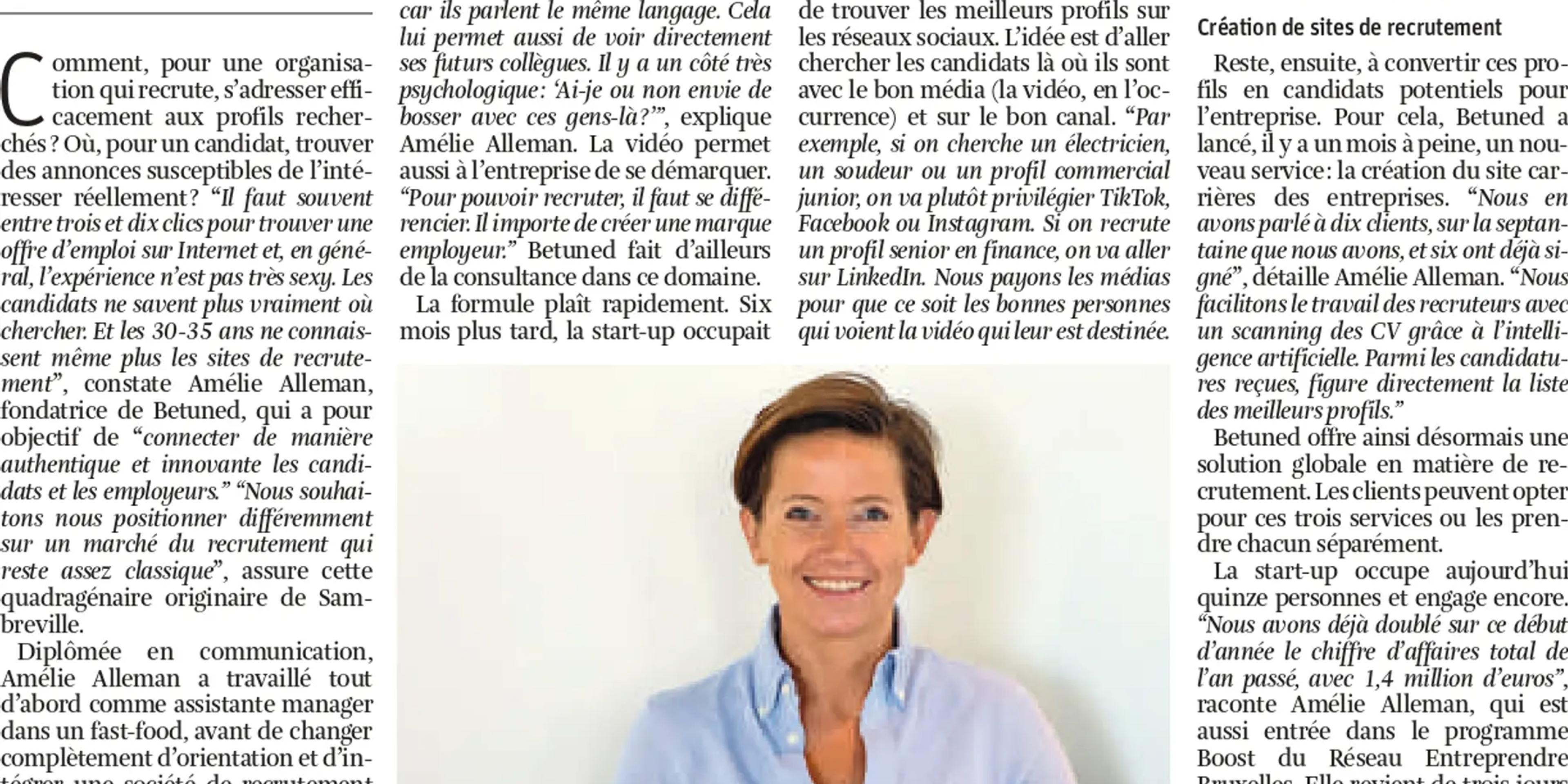Amélie Alleman, founder of Jobloom and Betuned, was recently a guest on the news channel LN24 to discuss the challenges of recruiting in SMEs and how technology can transform the candidate and recruiter experience.
During this interview, she reflects on her entrepreneurial journey, the origins of Jobloom, and the challenges that small and medium-sized enterprises face in attracting the right talent in a competitive market. She explains how Jobloom enables SMEs to create a dynamic career page, distribute their job offers with a single click, and manage applications easily thanks to artificial intelligence.
A clear, concrete, and inspiring exchange on the future of digitalized recruitment.
The latest

Comment digitaliser son recrutement en tant que PME ?
La digitalisation du recrutement est devenue essentielle pour les PME. Cet article vous explique comment :Offrir une expérience candidat fluide et mobile-first.Utiliser votre marque employeur comme levier d’attraction.Éviter les process éclatés grâce à une base centralisée.Automatiser les tâches répétitives pour gagner du temps.Diffuser efficacement vos offres d’emploi.Améliorer la collaboration interne autour du recrutement.Pourquoi digitaliser son recrutement ?Tout est devenu digital. On achète en quelques clics sur Amazon, on réserve ses vacances sur son smartphone… et les candidats s’attendent à la même simplicité quand ils postulent à un emploi.Le parallèle avec l’e-commerce est frappant : près de 3 acheteurs sur 5 abandonnent leur panier en ligne avant de finaliser.Dans le recrutement digital, c’est encore pire. Si le processus n’est pas fluide et pensé mobile, vous perdez vos talents avant même de les rencontrer.Un site carrière classique ne convertit que 0 à 2 % de ses visiteurs en candidats, alors qu’avec une expérience digitale optimisée (SEO, contenu marque employeur, mobile first), ce taux peut être multiplié par 10 et ainsi créer une véritable source d'acquisition des candidats.Digitaliser son recrutement est devenu un enjeu vital pour toute PME qui a besoin de talents.Digitaliser son recrutement avec un funnel de conversion candidat simpleComme en marketing, il faut penser funnel de conversion. Un candidat doit être guidé depuis l’endroit où il se trouve (Google Jobs, LinkedIn, réseaux sociaux, articles, jobboards spécialisés ...) jusqu’à l’acte de candidature.Les 3 étapes clés :Être présent là où se trouvent les candidats.Offrir une expérience sans friction, surtout sur mobile (plus de 90 % des candidatures se font sur smartphone).Permettre de postuler en un clic, via un CV ou un profil LinkedIn.Saviez-vous que 90 % des utilisateurs de LinkedIn en Belgique sont exclusivement sur mobile ?Utiliser sa marque employeurPourquoi un candidat choisirait-il votre PME plutôt qu’une autre société avec un poste et un salaire équivalents ? La réponse tient à votre marque employeur.Celle-ci doit être authentique. On oublie le “bullshit” et les beaux discours marketing : il faut parler vrai.Questions à se poser :Quelle est votre culture de travail ?Quelles sont vos valeurs et votre vision ?Quels projets concrets mènent vos équipes ?Quelles opportunités d’évolution ou formations proposez-vous ?84 % des candidats recherchent des informations sur la marque employeur avant de postuler, et ce chiffre grimpe encore pour les profils pénuriques.Un site carrière vide ou obsolète devient un frein majeur.Pensez aussi à adapter vos contenus selon vos profils cibles : un ouvrier, un ingénieur ou un IT n’auront pas les mêmes attentes ni le même langage.Éviter les process éclatésTrop de PME gèrent encore leurs recrutements via un mélange d’emails, d’Excel, de Dropbox ou Sharepoint. Résultat : des process éclatés et inefficaces.Exemples concrets :Un candidat déjà rencontré est recontacté par erreur.Un profil prometteur est perdu faute de base centralisée.Des retours candidats sont oubliés, ternissant l’image employeurUne base de données centraliséeLa clé de la digitalisation, c’est la centralisation des données.Avec un ATS (Applicant Tracking System), vous créez une base unique qui :Garde l’historique de chaque candidat,Partage les informations entre managers,Permet de constituer un vivier pour de futurs recrutements,Simplifie le rejet ou le suivi automatisé des candidatures.Ainsi, plus de pertes d’informations et un accès instantané à vos talents, même ceux rencontrés par le passé.Digitaliser son recrutement en automatisant les tâches chronophagesLe but n’est pas de remplacer l’humain, mais de libérer du temps.L’automatisation réduit les tâches opérationnelles pour se concentrer sur ce qui compte : la rencontre humaine.Exemples d’automatisations utiles :Création automatique de fiches candidats (lecture CV, compétences, langues, etc.).Envoi de refus automatisés et personnalisés.Relances d’anciennes candidatures.Tri des CV avec extraction des compétences clés.Qualification via formulaires courts.Génération automatique d’annonces, traductions, et contenus pour réseaux sociaux.Diffusion multi-plateformes automatisée.Avec l’IA, ces étapes deviennent encore plus fluides et précises.La diffusion automatisée des offres d'emploiPublier sur LinkedIn, Indeed ou Google Jobs semble simple, mais c’est chronophage.Les candidats sont dispersés sur plusieurs canaux : il faut donc multidiffuser efficacement.Grâce à des outils de multidiffusion, une annonce peut être publiée en un clic sur tous les canaux pertinents.Avantages :Gain de temps considérable.Visibilité maximale auprès des bons candidats.Couverture complète du marché de l’emploi sans effort supplémentaire.Faciliter la communication interneRecruter ne se fait jamais seul. Dans une PME, plusieurs acteurs interviennent : dirigeants, managers, RH…Sans outil central, la communication devient éclatée.Les bénéfices d’un outil centralisé :Notes et évaluations directement sur la fiche candidat.Suivi en temps réel des recrutements.Décisions tracées et transparentes.Résultat : un processus plus collaboratif, rapide et clair — gage de professionnalisme auprès des candidats.Conclusion : digitaliser son recrutement, une nécessité pour les PMENe pas digitaliser son recrutement, c’est perdre ses candidats avant même de les rencontrer.En résumé :Une expérience candidat mobile-first et fluide.Une marque employeur authentique et visible.Une base de données centralisée et intelligente.Des process automatisés pour se concentrer sur l’humain.Digitaliser son recrutement, c’est remettre l’humain au centre.

Je vois l’évolution d’un côté, le potentiel de l’autre. Et je savoure !
À gauche, Charlotte Courtat. Elle a commencé comme junior recruteuse chez Betuned. Aujourd’hui, elle est Product & Account Manager chez Jobloom. Trois ans à apprendre, tester, monter en puissance. Et franchement, quelle montée. Bravo Charlotte ! À droite, Romane Willemart. Elle a commencé cette semaine comme junior en communication digitale. Elle découvre tout, pose plein de questions, observe … et on sent déjà qu’elle ne va pas rester dans l’ombre bien longtemps. Welcome Romane ! Ce genre de photo, c’est plus qu’un cliché d’équipe. C’est un rappel que les talents, ça se révèle avec le temps, la confiance, et un peu d’espace pour oser. Et moi ? Je suis là, à regarder tout ça avec un mélange de fierté, d’admiration… et beaucoup d’enthousiasme pour la suite ! Let's Bloom !

Transforming is not reorganizing: The human survival guide for HR facing radical change.
70% of transformations fail due to the human factor. Discover the HR guide inspired by the RTBF case to successfully drive change and leave no one behind.I'm going to be honest with you. The word "transformation" tires me. It's heard everywhere, in every executive committee, on every PowerPoint slide. The problem? It's been emptied of its meaning. It's been reduced to org charts, processes, and tools. We've forgotten that transforming a company is, above all, about supporting human beings who are losing their bearings.When I spoke with Christine Thiran, HR Director of RTBF, I realized that I was dealing with a leader who had not forgotten. She steered one of the most profound transformations of the Belgian media landscape, not from an ivory tower, but from the trenches, staying close to her teams.His testimony is a powerful antidote to the dehumanization of change. Forget the consultants and complex diagrams. Here are the human lessons of a radical transformation.The initial shock: Accepting and naming the griefImagine the scene. You gather your top 200 executives. People who have built their careers, their professional identity, within an organization they know inside out. And then, you announce the news to them.Christine tells it bluntly: "They announced to all these executives that a large part would have to... they were going to revoke their mandate."The word is out: "withdraw". It's not a "career evolution", it's a loss. A loss of status, of benchmarks, of work relationships built over years. It is precisely at this moment, by denying the emotional impact, that most transformation plans sow the seeds of their own failure.What Christine and her team were smart to do was to name things. Her words are powerful and still resonate with me: "We have done a lot of support programs, grief management because cutting, breaking up teams like that... there is a mourning. It must be acknowledged, even if my boss was annoyed that I talked about it."Talking about "grief" in a corporate setting might seem excessive. Yet, it's exactly what the famous Elisabeth Kübler-Ross Change Curve models. Originally applied to the stages of grief, it perfectly describes the emotional stages an employee goes through when faced with a major change: shock, denial, anger, bargaining, sadness, and finally, acceptance. Ignoring these stages guarantees that resistance will take hold permanently.The Change Curve: Understanding the emotional phases of a transformation.The cardinal philosophy: "Leave no one behind"In the face of this emotional chaos, a single compass guided the actions of RTBF's HR director. A simple phrase, but one that changes everything."It was just essential not to leave anyone behind. [...] The worst thing is to leave people on the side. They won't understand and they will start to have thoughts that are not positive."This sentence is not just wishful thinking. It's a strategy. It's the belief that the energy spent on supporting each individual is an investment, not a cost. What does that actually mean? Christine explains having "motivated her teams to go out and find people", to understand why an executive hadn't applied for a new position, to ensure that everyone had an exit door or a clear transition path.This approach is the polar opposite of the traditional method that involves announcing the plan and letting people fend for themselves. The result? This figure is not a hunch, but a harsh reality. A seminal study by the Harvard Business Review ("The Hard Side of Change Management") confirms that nearly 70% of transformation initiatives fail.The main reason? Companies focus on the technical aspects (structure, process) and overlook the human element, the "soft side," which is actually the hardest to manage. By not leaving anyone behind, RTBF has not only shown humanity; it has defused the main time bomb of its project.(Source: "The Hard Side of Change Management", Harold L. Sirkin, Perry Keenan, and Alan Jackson, Harvard Business Review, October 2005. URL: https://hbr.org/2005/10/the-hard-side-of-change-management)The Mechanics of Success: Combining Purpose and StructureHaving a philosophy is good. Having a method to apply it is better. The famous John Kotter's 8-step change model provides a perfect framework for understanding the success of RTBF. Even if the company didn't consciously tick each box, the spirit of these key steps is evident in its approach.Here are the 8 steps of Kotter's model:Create a sense of urgency.Form a powerful leading coalition.Develop a vision and a strategy.Communicate the vision for change.Empower employees to take action.Generate short-term wins.Consolidate achievements and generate even more change.Anchor new approaches in the corporate culture.In her testimony, Christine particularly emphasizes the steps 1, 4, and 6. The urgency (the media's survival against new practices), the communication of the vision ("We spent a lot of time explaining the meaning, the why. [...] Having a storytelling that made sense.") and the short-term victories (the promise of internal mobility, initially met with skepticism but proven by the numbers: 146 out of 154 positions filled internally) were the visible pillars of their success.What I take away, as a leader...RTBF's journey is not just a simple reorganization. It's a masterclass on leadership in times of crisis. It reminds us that our role, as HR leaders, is not to draw boxes, but to hold hands. To acknowledge the pain, to set a clear direction, and to never, ever, consider people as a variable to be adjusted.True transformation is not measured by the beauty of the new organizational chart, but by the resilience and trust of the teams that have gone through it.And you, in your transformations, how do you ensure that no one is left behind?Want to go further?This question leads to another, equally crucial one: once the new structure is in place, how can we ensure that the new roles are clear, motivating, and truly aligned with the vision? Because there is a great risk of falling back into old habits with job descriptions that do not reflect the change.Changing roles on paper is one thing. Bringing them to life is another. It's a challenge I face every day. That's why we organize sessions d'introduction à Jobloom, short and interactive. The goal? To show you concretely how to rethink your mission descriptions to turn them into real management and motivation tools.To discover a method and concrete examples, join one of our upcoming sessions. Inspiration is guaranteed.

Quand j’ai accouché, on m’a dit : « Il faut tout un village pour élever un enfant. » Aujourd’hui, je peux vous dire qu’il en faut deux pour faire grandir une start-up.
Parce qu'entreprendre, ce n’est pas juste « kiffer sa liberté » et « disrupter des marchés ». C’est se lever avec 1000 idées et se coucher avec 1000 doutes. (Quand on a le luxe de dormir, évidemment). 🙃 Et dans tout ce chaos, on a besoin d'alliés. Des vrais. Nos investisseurs en font partie. Mais je ne parle pas ici d’un chèque et d’un pouce levé en visio chaque trimestre. Je parle de gens qui s'impliquent, qui s'exposent, qui prennent des risques avec toi. Je parle de gens qui : 👉 décryptent tes silences. 👉 te disent ce que tu n’as pas envie d’entendre. 👉 t’aident à transformer une intuition floue en plan d’action clair. Parce que oui, les boards, c’est bien. Mais c’est souvent trop espacé, trop superficiel, trop poli, trop verni. Trop loin du réel. Alors chezJobloom, j'ai voulu faire autrement. On a organisé notre tout premier Investor Day avec des ateliers de réflexion. Et on a travaillé, ensemble. Et franchement ? Cela m'a fait beaucoup de me sentir soutenue et entourée. C’est ça, la smart money pour moi. 😊 Pas juste du cash mais de l’écoute, du cerveau, du temps offert. Le plus dur maintenant ? Faire durer ça. En faire une habitude. Un réflexe collectif. Et amplifier encore la dynamique. À tous ceux qui investissent avec le cœur, la tête et le temps : merci. 🙏 Vous ne financez pas juste des boîtes. Vous aidez à rendre l’impossible… un peu plus possible. Et pour nous, fondateurs… ça change tout. Vraiment.
You might also like

Discover Jobloom in La Libre Echo.
La Libre Echo features Amélie Alleman, founder of Jobloom, in an inspiring portrait of her entrepreneurial journey and the creation of a recruitment solution designed for SMEs. An article that looks back at the birth of Jobloom, its innovative positioning, and its mission: to simplify recruitment through technology.Amélie Alleman honored in La Libre Echo: a look back at the genesis of JobloomWe are pleased to share a great article published in the weekend edition of La Libre Echo (April 26-27, 2025), which devotes an entire page to Amélie Alleman, founder of Jobloom and Betuned.In this portrait, journalist Pierre-François Lovens reflects on Amélie's entrepreneurial journey and how her two projects – complementary and decidedly focused on innovation – are reinventing recruitment in SMEs.The article highlights the origin of Betuned, a specialized agency in employer branding through video, and then the natural evolution towards Jobloom, an all-in-one SaaS platform designed to digitize, automate, and simplify the entire recruitment process.Amélie shares transparently her transition from the service sector to tech, her pragmatic approach to AI applied to HR, as well as the vision behind Jobloom: to make recruitment simpler, more human, and more efficient for companies that don't have the time or resources of a large group.

Inspiring Entrepreneurs
🎙️This summer, I had the pleasure of being invited to participate in Geoffroy Josquin's podcast "Les Entrepreneurs Inspirants". It was a really nice moment of sharing with Geoffroy. We talked about: • The importance of innovation in recruitment • The origin of Betuned and what motivated me to get started • The team, having the right people in the right place • The human challenges that can be encountered • How to juggle being a mom and a business owner A big thank you to Geoffroy Josquin for this enriching conversation. I hope it will inspire others to embark on entrepreneurship!Discover the video podcast on YouTube: https://www.youtube.com/watch?v=jTtcBGChFJAThe podcast is also available on all traditional podcast platforms: Spotify, Deezer, Apple Podcasts, Google, Amazon Happy listening!

Betuned is being talked about in Trends-Tendances!
Re-Connect, the podcast inspired by the eponymous book by Georges-Alexandre Hanin, features entrepreneurs and their stories. This week, Amélie Alleman was on the microphone!Amélie Alleman has already founded two companies. The first with a partner whose skills complemented hers, the second, she wanted to launch on her own. Her overflowing creativity has provided her with countless resources from which she has drawn unexpectedly to equip herself in areas that were less familiar to her.Listen to the episode on Spotify or on Apple Music.📢 Discover all the Betuned services: make an appointmentYou can also contact us: [email protected] or 0474548989

Look for candidates where they are
Discover the article by Amélie Alleman, founder of Betuned, in La Libre Belgique.Betuned offers a comprehensive solution to make recruitment more efficient.How can an organization that is hiring effectively reach out to the profiles it is searching for? Where can a candidate find job postings that truly interest them? “It often takes between three and ten clicks to find a job offer on the internet, and generally, the experience is not very appealing. Candidates no longer really know where to look. And those who are 30-35 years old don’t even know the recruitment sites anymore,” observes Amélie Alleman, founder of Betuned, whose goal is to “authentically and innovatively connect candidates and employers.” “We aim to position ourselves differently in a recruitment market that remains quite traditional,” assures this entrepreneur from Sambreville.Graduated in communication, Amélie Alleman first worked as an assistant manager in a fast food restaurant, before completely changing her career path and joining a recruitment company specialized in IT. In 2009, she founded her own consultancy and IT recruitment company (which has since been sold) and then a second one in the same field. Keen to reinvent the recruitment offering, she launched Betuned at the end of 2019.Behind the scenesInitially, she offers videos of companies that are hiring to show candidates the DNA of the company and what goes on behind the scenes. "We go into the company and interview the manager and colleagues with whom the future candidate will work. It's interesting for them because they speak the same language. It also allows them to directly see their future colleagues. There's a very psychological aspect: 'Do I want to work with these people or not?'" explains Amelie Alleman. The video also allows the company to stand out. "To be able to recruit, you have to differentiate yourself. It's important to create an employer brand." Betuned also provides consultancy in this area.The formula quickly became popular. Six months later, the startup already employed six people and had about twenty clients. As it expanded, Betuned added a second service to its offering: the creation of digital marketing campaigns to find the best profiles on social networks. The idea is to reach out to candidates where they are with the right media (video, in this case) and on the right channel. “For example, if we're looking for an electrician, a welder, or a junior sales profile, we'll favor TikTok, Facebook, or Instagram. If we're recruiting a senior profile in finance, we'll go on LinkedIn. We pay the media so that the right people see the video that's intended for them.Digital marketing allows targeting talents,” explains Amélie Alleman, who can search for all types of profiles “because we go looking for candidates where they are.”Recruitment website creationThe next step is to convert these profiles into potential candidates for the company. To do this, Betuned launched a new service just a month ago: the creation of career sites for companies. “We discussed it with ten clients, out of the seventy we have, and six have already signed up,” explains Amélie Alleman. “We make the recruiters' job easier by scanning CVs with artificial intelligence. Among the applications received, the list of the best profiles is directly available.”Betuned now offers a comprehensive solution for recruitment. Clients can choose these three services together or select each one separately.The startup currently employs fifteen people and is still hiring. “We have already doubled this year's total revenue compared to last year, with 1.4 million euros,” shares Amélie Alleman, who has also joined the Boost program of the Réseau Entreprendre Bruxelles. She has just returned from a three-day workshop where she prepared the company's three-year growth plan. In terms of financing, Betuned has received a 250,000 euro loan from finance.brussels and at the end of December, received support from two private investors who invested a total of 250,000 euros. “We are considering a larger fundraising round in about a year or a year and a half. To be confirmed.”Would you like to learn more about Betuned or a demo of our services? Do not hesitate to contact us to discuss it! [email protected] or +32474548989!